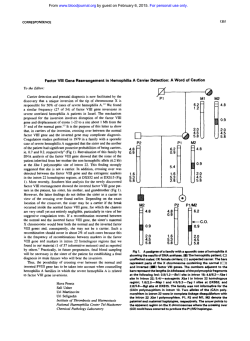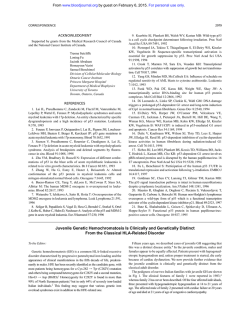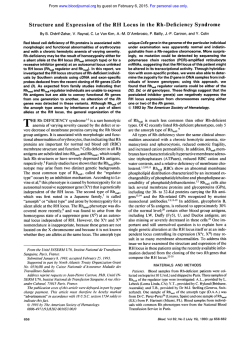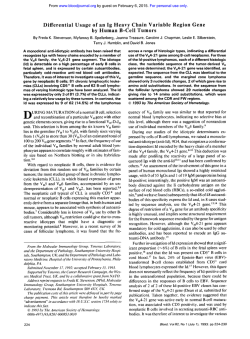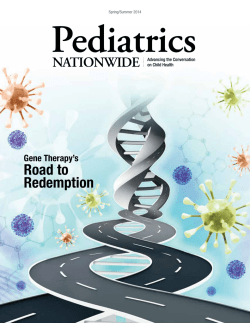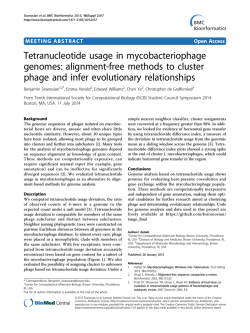
Association of polymorphisms and pairwise
89 Chapter 7 Association of polymorphisms and pairwise haplotypes in the elastin gene in Dutch patients with subarachnoid hemorrhage from non-familial aneurysms Ynte M. Ruigrok, Uli Seitz, Silke Wolterink, Gabriël J.E. Rinkel, Cisca Wijmenga, and Zsolt Urbán Stroke 2004; 35: 2064-2068 90 Chapter 7 Abstract Background and purpose A locus containing the elastin gene has been linked to familial intracranial aneurysms in 2 distinct populations. We investigated the association of single-nucleotide polymorphisms (SNPs) and haplotypes of SNPs in the elastin gene with the occurrence of subarachnoid hemorrhage (SAH) from sporadic aneurysms in the Netherlands. Methods We genotyped 167 SAH patients and 167 matching controls for 18 exonic and intronic SNPs in the elastin gene. A Bonferroni correction was applied for multiple comparisons with all novel associations, with a correction factor derived from the number of SNPs tested (p-value after Bonferroni correction [pcorr]). Results SAH was statistically significant associated with a SNP in exon 22 of the elastin gene (minor allele frequency was 0.000 in patients and 0.028 in controls; odds ratio [OR], 0.0; 95% CI, 0.0 to 0.7; p=0.004; pcorr=0.05) and possibly with an SNP in intron 5 (minor allele frequency was 0.062 in patients and 0.128 in controls; OR, 0.5; 95% CI, 0.2 to 0.8; p=0.007; pcorr =0.08). Haplotypes of intron 5/exon 22 (pcorr =0.002), intron 4/exon 22 (pcorr=0.02), and intron 4/intron 5/exon 22 (p=9.0x10-9) were also associated with aneurysmal SAH. Conclusions Variants and haplotypes within the elastin gene are associated with the risk of sporadic SAH in Dutch patients. Gradual increase of statistical power with the inclusion of 2 or 3 SNPs in the studied haplotypes supports the validity of our conclusion that the elastin gene is a susceptibility locus for SAH. Elastin gene variants in subarachnoid hemorrhage 91 G enetic factors are likely to be involved in the development of intracranial aneurysms (IAs) because familial predisposition is the strongest risk factor for aneurysmal subarachnoid hemorrhage (SAH).1,2 Familial clustering is found in approximately 10% of patients with SAH, and first-degree relatives of patients with SAH have a 3 to 7 times greater risk of developing SAH than the general population.1 In many ruptured IAs, the arterial wall contains reduced amounts of extracellular matrix proteins.3,4 Elastin is an important structural protein of this extracellular matrix and is mainly confined to the internal elastic lamina in intracranial arteries.5 Elastin has been proposed as a functional candidate gene for IA because defects in the internal elastic lamina have been found in IAs.6-8 Recently, elastin has also been suggested to be a positional candidate gene for familial IA because a genomewide and a locus-specific linkage study in affected sib pairs and affected pedigree members, respectively, showed linkage to a region on chromosome 7q11 that includes the elastin gene.9,10 The gene was analyzed further for allelic and haplotype associations in a sample with equal numbers of sporadic and familial patients with SAH from Japan.9 Although no allelic association was found with any of the 14 single-nucleotide polymorphisms (SNPs) investigated in the elastin gene, the haplotype constructed from the intron 20 (INT20) and INT23 polymorphisms was strongly associated with IA (p=3.81 x 10-6),9 which further supported a locus for IA within or near the elastin gene. However, an additional genome-wide and a locusspecific linkage study of IA failed to provide positive results for 7q11.11,12 Furthermore, the INT20/INT23 haplotype was not associated with IA in a sample from Central Europe.13 To investigate the role of the elastin gene in sporadic SAH patients further, we studied the association of 18 exonic and intronic SNPs, including the 14 SNPs analyzed previously,9 and haplotypes of pairwise combinations of these SNPs in the elastin gene with sporadic, aneurysmal SAH in the Dutch population. Patients and Methods Patient and control recruitment We included 167 consecutive Dutch patients with sporadic aneurysmal SAH admitted to the University Medical Center Utrecht and 167 age- and sex-matched Dutch controls. Patients with aneurysmal SAH were defined by symptoms suggestive of SAH combined with subarachnoid blood on computed tomography (CT) and a proven aneurysm on CT angiography or conventional angiography. The matched controls were selected from the database of the Department of Medical 92 Chapter 7 Table 1. Characteristics of the analyzed polymorphisms in the elastin gene. SNP name Location/Position PM1 PM2 PM3 INT1 INT4 EX5 INT5 INT6 INT8 INT14 EX20 1 EX20 2 INT20 EX22 INT23 EX26 INT26 INT32 3UTR Promoter -1042 Promoter -972 Promoter -38 Intron 1 Intron 4 196+71 Exon 5 212 Intron 5 233-94 Intron 6 326-59 Intron 8 427+92 Intron 14 746-28 Exon 20 1192 Exon 20 1264 Intron 20 1315+17 Exon 22 1380 Intron 23 1501+24 Exon 26 1828 Intron 26 1934-20 Intron 32 2273-34 3’-UTR 659 Nucleotide change C>T G>A C>T (CCTT)n repeat G>A C>T G>A G>A G>C G>A G>C G>A T>C G>A T>C G>C C>T C>T G>C Amino acid change Ala>Val Gly>Arg Gly>Ser Leu>Leu Gly>Arg Ala: alanine; Val: valine; Gly: glycine; Arg: arginine; Ser: serine; Leu: leucine. Genetics, which includes healthy family members of patients with diverse diseases. The ethical review board of our hospital approved our study protocol. Polymorphisms in the elastin gene We analyzed 18 exonic and intronic SNPs (Table 1), of which 14 were analyzed previously in Japanese SAH patients.9 We also included 4 previously published SNPs14 and 1 SNP from the SNP database (ID rs2229427). Furthermore, a tetranucleotide repeat polymorphism within INT19,15 was analyzed because this polymorphism showed allelic association with aneurysmal SAH in a previous study.9 A map of the elastin gene with informative polymorphisms is shown in Figure 1. Laboratory analyses Genotyping of the SNPs in the elastin gene was performed with coded genomic DNA samples using a multiplex fluorescent primer extension assay.16 For all reac- Elastin gene variants in subarachnoid hemorrhage 93 Figure 1. Location of informative polymorphisms in the elastin gene. Location of informative polymorphisms investigated in this study is shown by tie lines to a schematic representation of the elastin gene. The promoter region, introns and 3’-untranslated region (3’-UTR) of the elastin gene are shown by solid lines. Exons are indicated by boxes on the basis of the nature of domains encoded. Open boxes: hydrophobic domains; full boxes: crosslink domains; hatched boxes: signal peptide and C-terminal cysteine-containing domains. Exons subject to alternative splicing in dermal fibroblasts (Z. Urbán et al., unpublished data, 2004) are indicated by asterisks. Different scaling was used for drawing exons and introns as indicated by scale bars below the diagram (bp: base pairs; kbp: kilobase pairs). tions, we used no template negative controls and sequence-confirmed positive controls for each available genotype. Assay conditions are available upon request. Genotyping results were verified by review of the chromatograms by 2 independent observers. Discordant or missing genotype calls were subjected to genotyping by direct sequence analysis of both strands. The tetranucleotide repeat polymorphism within INT1 was detected by polymerase chain reaction.15 Statistical analysis Statistical analysis of the haplotype frequency and linkage disequilibrium (LD) calculations were conducted using the COCAPHASE option of the software UNPHASED v2.402 which uses likelihood ratio tests in a log-linear model.17 The calculated LD statistics included global D’ and Pearson χ2 tests.18 Differences in allele frequencies of each SNP between patients and controls were assessed as an odds ratio (OR) of the minor allele with a corresponding 95% CI and p-value using the major allele as reference. In analyzing haplotypes, the OR of the most frequent haplotype for a given combination of SNPs was assessed by using the remaining haplotypes as reference. A Bonferroni correction (a multiple-comparison correction) was applied to all significant associations, with a correction factor derived from the number of SNPs or haplotypes tested (p-value after Bonferroni correction [pcorr]). For the tetranucleotide repeat polymorphism in INT1, differences in allele frequencies between patients and controls were compared using χ2 test comparing 94 Chapter 7 Table 2. SNP genotype and allele frequencies in patients with aneurysmal SAH vs controls. SNP INT4 (n=151) INT5 (n=144) INT6 (n=132) INT8 (n=146) EX20 2 (n=155) INT20 (n=149) EX22 (n=145) INT23 (n=138) EX26 (n=145) INT26 (n=141) INT32 (n=161) 3UTR (n=150) Genotype GG GA AA GG GA AA GG GA AA GG GC CC GG GA AA TT TC CC GG GA AA TT TC CC GG GC CC CC CT TT CC CT TT GG GC CC Patients, n (%) Controls, n (%) H-W 140 (92.7%) 10 (6.6%) 1 (0.7%) 127 (88.2%) 16 (11.1%) 1 (0.7%) 113 (85.6%) 18 (13.6%) 1 (0.8%) 129 (88.4%) 17 (11.6%) 0 (0%) 55 (35.5%) 69 (44.5%) 31 (20.0%) 106 (71.2%) 37 (24.8%) 6 (4.0%) 145 (100%) 0 (0%) 0 (0%) 43 (31.1%) 68 (49.3%) 27 (19.6%) 128 (88.4%) 16 (11.0%) 1 (0.7%) 139 (98.6%) 2 (1.4%) 0 (0%) 127 (78.9%) 30 (18.6%) 4 (2.5%) 77 (51.3%) 66 (44.0%) 7 (4.7%) 134 (88.8%) 15 (9.9%) 2 (1.3%) 117 (81.3%) 17 (11.8%) 10 (6.9%) 115 (87.1%) 14 (10.6%) 3 (2.3%) 128 (87.7%) 17 (11.6%) 1 (0.7%) 56 (36.1%) 79 (51.0%) 20 (12.9%) 94 (63.1%) 52 (34.9%) 3 (2.0%) 140 (96.5%) 2 (1.4%) 3 (2.1%) 43 (31.1%) 72 (52.2%) 23 (16.7%) 123 (84.8%) 22 (15.2%) 0 (0%) 136 (96.5%) 5 (3.5%) 0 (0%) 112 (69.6%) 49 (30.4%) 0 (0%) 62 (41.3%) 81 (54.0%) 7 (4.7%) 0.94 0.87 0.92 0.93 0.62 0.80 0.57 0.92 0.98 0.57 0.69 H-W: p-value for χ2 test of Hardy -Weinberg equilibrium for SNPs with a minor allele Elastin gene variants in subarachnoid hemorrhage 95 Allele Patients, n (%) Controls, n (%) OR 95% CI p G A 290 (96.0%) 12 (4.0%) 283 (93.7%) 19 (6.3%) 0.6 0.3-1.4 0.20 G A 270 (93.8%) 18 (6.2%) 251 (87.2%) 37 (12.8%) 0.5 0.2-0.8 0.007 G A 244 (92.4%) 20 (7.6%) 244 (92.4%) 20 (7.6%) 1.0 0.5-2.0 1.0 G C 275 (94.2%) 17 (5.8%) 273 (93.4%) 19 (6.6%) 0.9 0.4-1.8 0.73 G A 179 (85.2%) 131 (4.8%) 191 (91.0%) 119 (9.0%) 1.2 0.8-1.6 0.33 T C 249 (83.6%) 49 (16.4%) 240 (80.5%) 58 (19.5%) 0.8 0.5-1.3 0.34 G A 290 (100%) 0 (0%) 282 (97.2%) 8 (2.8%) 0.0 0.0-0.7 0.004 T C 154 (55.8%) 122 (44.2%) 158 (57.2%) 118 (42.8%) 1.1 0.8-1.5 0.73 G C 272 (93.8%) 18 (6.2%) 268 (92.4%) 22 (7.6%) 0.8 0.4-1.6 0.51 C T 280 (98.9%) 2 (1.1%) 277 (97.3%) 5 (2.7%) 0.4 0.1-2.3 0.25 C T 284 (88.2%) 38 (11.8%) 273 (84.8%) 49 (15.2%) 0.8 0.5-1.2 0.20 G C 220 (73.3%) 80 (26.7%) 205 (68.3%) 95 (31.2%) 0.8 0.5-1.1 0.17 frequency of >5% in the control group. pcorr 0.08 0.05 96 Chapter 7 only alleles with frequencies >5.0%. Our study was performed in a paired fashion. Therefore, data were analyzed only if genotypes were available for both individuals in a patient-control pair. Tests for Hardy-Weinberg equilibrium were conducted using χ2 tests. Assuming a recessive disease locus,9 our cohort of 167 cases and 167 controls had an 80% power to detect a susceptibility locus with a relative risk of >1.2 at a significance level of 0.05 when testing SNPs with minor allele frequencies of >0.025 (genetic power calculator, SGDP Statistical Genetics Group). Results The SNPs PM1, PM2, PM3, exon 5 (EX5), INT14 and EX20 1 were not polymorphic in our population. Distribution of the genotypes of the remaining 12 SNPs and the tetranucleotide repeat polymorphism was consistent with Hardy-Weinberg equilibrium (Table 2). SAH association with elastin gene alleles We compared allele frequencies of the remaining 12 polymorphic SNPs between patients and controls (Table 2). The EX22 SNP was associated with aneurysmal SAH because 0% of the patients were carriers of the minor allele compared with 2.8% of the controls (OR, 0.0; 95% CI, 0.0 to 0.7; p=0.004). After Bonferroni correction, the association remained statistically significant (pcorr=0.05). The INT Table 3. Association study with haplotypes consisting of pairwise combination of alleles of SNPs EX 22, INT4 and INT 5 in SAH patients vs controls. Haplotype Patients (%) Controls (%) p* pcorr INT4 EX22 (G,G) 95.8% (A,G) 4.2% (G,A) 0% (G,G) 89.7% (A,G) 7.2% (G,A) 3.1% 0.001 0.02 INT5 EX22 (G,G) 93.4% (A,G) 6.6% (G,A) 0% (G,G) 83.3% (A,G) 13.6% (G,A) 3.1% 7.7x10-5 0.002 *: p-value for Pearson’s χ2 statistical comparison of haplotype frequencies of patients vs controls. pcorr: p-value after Bonferroni correction. Elastin gene variants in subarachnoid hemorrhage 97 Figure 2. Pairwise LD between SNPs in the elastin gene in control individuals. D’ value is a measure of LD with values between 0 and 1; D’ values between 0.7 and 1.0 are considered to be an evidence of LD. Shading indicates D’>0.70 and p<0.05. 5 SNP showed association with aneurysmal SAH with 6.2 % carriers of the minor allele in the patient group versus 12.8% in the control group (OR, 0.5; 95% CI, 0.2 to 0.8, p=0.007). After applying Bonferroni correction, this p-value was no longer statistically significant (pcorr =0.08). The remaining 10 SNPs were not associated with aneurysmal SAH. Allele frequencies of the tetranucleotide repeat polymorphism in INT 1 were not significantly different in patients with aneurysmal SAH and controls (p=0.37; 4 df, data not shown). SAH association with elastin gene haplotypes We constructed haplotypes using all 21 possible pairwise SNP combinations that included SNPs EX22 and INT5. Haplotype association with SAH was found for all haplotypes involving SNP EX22 and almost all haplotypes involving SNP INT5 (except for INT5/INT6, INT5/INT8, and INT5/INT23). After Bonferroni correction, association with haplotypes of INT5/EX22 remained statistically significant (pcorr=0.002; Table 3). The G,G haplotype (major alleles for both INT5 and EX22) was more prevalent in patients than in controls (OR, 2.6; 95% CI, 1.2 to 5.8). In addition, association with haplotypes of INT4/EX22 also remained significant after correction (pcorr=0.02; Table 3). The G,G haplotype (major alleles for INT4 and EX22) was also more prevalent in patients than in controls (OR, 2.8; 95% CI, 1.5 to 5.4). As expected, haplotypes of SNP combination INT4/INT5/EX22 were even more strongly associated with SAH (p=9.0x10-9) with the G,G,G haplotype being more prevalent in patients than in controls (90% versus 76%, OR, 2.9; 95% CI, 1.7 to 4.8). 98 Chapter 7 LD pattern within the elastin gene Because many SNPs in the elastin gene have relatively low minor allele frequencies, many LD analyses showed high p-values. In our LD analyses, we only show the results with a p-value <0.05 (Figure 2). Pairwise analysis showed an irregular pattern of LD between SNPs in the control patients with an overall weak LD (Figure 2). A possible ancestral haplotype INT20/INT23/INT32/3UTR did not show haplotype association in patients with aneurysmal SAH and controls. The LD pattern was similar in controls and SAH patients (data not shown). Discussion In a series of Dutch patients with sporadic aneurysmal SAH, we found a significant association with an SNP EX22 with more carriers of the minor allele in the control group. An explanation for this finding may be that the minor allele or an allele in disequilibrium with it is protective of SAH. Furthermore, we found that the haplotypes INT5/EX22, INT4/EX22, and haplotype INT4/INT5/EX22 also showed significant association with aneurysmal SAH. Gradual increase of statistical power with the inclusion of 2 or 3 SNPs in the studied haplotypes supports the validity of our conclusion that the elastin gene is a susceptibility locus for SAH. Allele frequencies of the elastin gene differ between Dutch and Japanese populations.9 Six of the SNPs described in the Japanese patients were not polymorphic in the Dutch population. Moreover, the association of aneurysmal SAH with the haplotype between the INT20/INT23 polymorphism and the (CCTT) repeat microsatellite in INT1 of the elastin gene9 was not confirmed in our study. Differences in study populations may in part explain the differences found. We only included patients without a known positive family history for IA, whereas the Japanese study population consisted of approximately 50% of patients with a positive family history. In addition, we used a clinically homogeneous population of only patients with aneurysmal SAH, whereas the Japanese study included not only patients with aneurysmal SAH but also patients with unruptured IA. Another explanation for the differences between the studies is that historical isolation has led to different allele frequencies and haplotype structure across populations.19 If this is true, population-specific variants may contribute to the risk of SAH and IA. Such variations may, for example, play a role in the difference in SAH incidence, which is 3x higher in Japan (and in Finland) than in other parts of the world.20,21 Our results also replicate the findings that in 30 familial and 175 sporadic SAH patients from Central Europe, no allellic association of the haplotype between the Elastin gene variants in subarachnoid hemorrhage 99 INT20/INT23 polymorphism was found.13 These authors also suggested allelic heterogeneity between Japanese and European populations of SAH patients. Further indication of possible population differences is that linkage to chromosome 7q11 demonstrated in Japanese9 and North American10 SAH patients was not confirmed in 2 other linkage-mapping studies.11,12 A strength of our study was that we used patient-control pairs matched by age and sex to minimize differences in SAH risk between cases and controls. In addition, to prevent genotyping bias, the study was conducted in a blinded fashion. We investigated a large number of SNPs, which increase the risk of finding a falsepositive association of a genotype with aneurysmal SAH by chance. However, in this study, analyses with a large number of SNPs were necessary because LD between the SNPs was generally low. Furthermore, we applied a Bonferroni correction to all novel associations to reduce the risk of finding false-positive associations. The analyzed SNPs in the elastin gene did not show strong LD. These results are consistent with the LD analysis in the Japanese population, in which the LD for SNPs in the elastin gene was also very weak.9 Boundaries between haplotype blocks correlate with meiotic recombination hot spots.22 Although recombination rates within the elastin gene locus have not been investigated directly, a previous report of a de novo recombination between 2 mutations in the elastin gene23 suggested that the elastin gene may be a recombination hot spot, which would explain the lack of LD in this locus. The elastin protein consists of lysine-rich cross-linking domains and hydrophobic domains responsible for elastic properties. The domain structure of the protein is a reflection of the exon organization of the gene because the hydrophobic and cross-linking domains are encoded by separate exons. The primary transcript of the gene is alternatively spliced.24,25 Exonic SNPs or intronic polymorphisms located close to exons may alter efficiency of the splicing and thus change the domain content of the resulting polypeptide. SNPs INT4, INT5, and EX22 are flanking or are located within such alternatively spliced exons. Altered domain content of the corresponding elastin may confer resistance to the pathogenic mechanism leading to IA rupture. References 1. Bromberg JE, Rinkel GJ, Algra A, et al. Subarachnoid haemorrhage in first and second degree relatives of patients with subarachnoid haemorrhage. BMJ 1995; 311: 288-289. 100 2. 3. 4. 5. 6. 7. 8. 9. 10. 11. 12. 13. 14. 15. 16. 17. 18. 19. 20. 21. 22. 23. 24. 25. Chapter 7 Ruigrok YM, Buskens E, Rinkel GJ. Attributable risk of common and rare determinants of subarachnoid hemorrhage. Stroke 2001; 32: 1173-1175. Chyatte D, Reilly J, Tilson MD. Morphometric analysis of reticular and elastin fibers in the cerebral arteries of patients with intracranial aneurysms. Neurosurgery 1990; 26: 939-943. Ostergaard JR, Oxlund H. Collagen type III deficiency in patients with rupture of intracranial saccular aneurysms. J Neurosurg 1987; 67: 690-696. Stehbens WE. Pathology of the cerebral blood vessels. St. Louis, Mo: Mosby; 1972. Sekhar LN, Heros RC. Origin, growth, and rupture of saccular aneurysms: a review. Neurosurgery 1981; 8: 248-260. Stehbens WE. Histopathology of cerebral aneurysms. Arch Neurol 1963; 8: 272-285. Stehbens WE. Etiology of intracranial berry aneurysms. J Neurosurg 1989; 70: 823-831. Onda H, Kasuya H, Yoneyama T, et al. Genomewide-linkage and haplotype-association studies map intracranial aneurysm to chromosome 7q11. Am J Hum Genet 2001; 69: 804819. Farnham JM, Camp NJ, Neuhausen SL, et al. Confirmation of chromosome 7q11 locus for predisposition to intracranial aneurysm. Hum Genet 2004; 114: 250-255. Olson JM, Vongpunsawad S, Kuivaniemi H, et al. Search for intracranial aneurysm susceptibility gene(s) using finnish families. BMC Med Genet 2002; 3: 7. Yamada S, Utsunomiya M, Inoue K, et al. Absence of linkage of familial intracranial aneurysms to 7q11 in highly aggregated Japanese families. Stroke 2003; 34: 892-900. Hofer A, Hermans M, Kubassek N, et al. Elastin polymorphism haplotype and intracranial aneurysms are not associated in central Europe. Stroke 2003; 34: 1207-1211. Urban Z, Michels VV, Thibodeau SN, et al. Isolated supravalvular aortic stenosis: functional haploinsufficiency of the elastin gene as a result of nonsense-mediated decay. Hum Genet 2000; 106: 577-588. Urban Z, Csiszar K, Fekete G, Boyd CD. A tetranucleotide repeat polymorphism within the human elastin gene (elni1). Clin Genet 1997; 51: 133-134. Lindblad-Toh K, Winchester E, Daly MJ, et al. Large-scale discovery and genotyping of single-nucleotide polymorphisms in the mouse. Nat Genet 2000; 24: 381-386. Dudbridge F. Pedigree disequilibrium tests for multilocus haplotypes. Genet Epidemiol 2003; 25: 115-121. Hedrick PW. Gametic disequilibrium measures: proceed with caution. Genetics 1987; 117: 331-341. Dean M, Stephens JC, Winkler C, et al. Polymorphic admixture typing in human ethnic populations. Am J Hum Genet 1994; 55: 788-808. Linn FH, Rinkel GJ, Algra A, van Gijn J. Incidence of subarachnoid hemorrhage: role of region, year, and rate of computed tomography: a meta-analysis. Stroke 1996; 27: 625-629. Ohkuma H, Fujita S, Suzuki S. Incidence of aneurysmal subarachnoid hemorrhage in Shimokita, Japan, from 1989 to 1998. Stroke 2002; 33: 195-199. Jeffreys AJ, Kauppi L, Neumann R. Intensely punctate meiotic recombination in the class II region of the major histocompatibility complex. Nat Genet 2001; 29: 217-222. Urban Z, Zhang J, Davis EC, et al. Supravalvular aortic stenosis: genetic and molecular dissection of a complex mutation in the elastin gene. Hum Genet 2001; 109: 512-520. Fazio MJ, Olsen DR, Kuivaniemi H, et al. Isolation and characterization of human elastin cDNAs, and age-associated variation in elastin gene expression in cultured skin fibroblasts. Lab Invest 1988; 58: 270-277. Indik Z, Yeh H, Ornstein-Goldstein N, et al. Alternative splicing of human elastin mRNA indicated by sequence analysis of cloned genomic and complementary DNA. Proc Natl Acad Sci USA 1987; 84: 5680-5684.
© Copyright 2025
